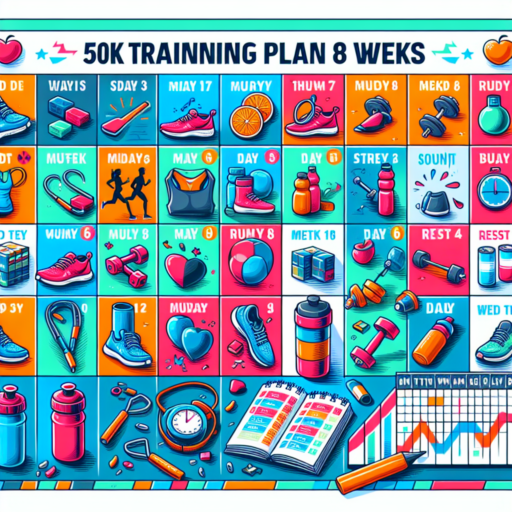The Ultimate 20-Week 50K Training Plan for Beginners
Embarking on a 50K run is an ambitious goal, especially for beginners. The Ultimate 20-Week 50K Training Plan is meticulously crafted to take you from your current level of fitness to crossing the finish line of a 50K race. This journey isn’t just about building the stamina and strength needed for such a distance; it’s also about fostering a mindset that embraces challenge and celebrates progress.
The plan kicks off with a focus on establishing a solid running base, gradually increasing your mileage in a manner that’s both challenging and sustainable. To prevent injury and encourage steady improvement, the program intersperses rest days and cross-training. This balanced approach ensures that you’re not just hammering away at the miles but also giving your body the recovery it needs to adapt and grow stronger.
A key component of the Ultimate 20-Week 50K Training Plan is its emphasis on variety in training. You’ll encounter long slow distance runs (LSD), tempo runs, and even speed work. This variation not only keeps your training schedule engaging but also equips your body to handle the different demands of endurance running. Through this plan, you’ll build not just the physical but also the mental fortitude required to tackle your first 50K race with confidence.
What to Know Before Starting Your 50K Training Journey
Embarking on a 50K training journey is an exhilarating endeavor that marks the beginning of an intensive period of physical and mental preparation. Before you lace up your running shoes and hit the track, there are several key aspects you should be well aware of to ensure your training is not only effective but also safe. Understanding these principles can make the difference between successfully crossing the finish line and facing unnecessary hurdles.
Developing a Realistic Training Plan
Your 50K success hinges on a well-structured and realistic training plan. It’s important to assess your current fitness level and gradually increase your mileage to avoid the common pitfall of overtraining. Including rest days and lower mileage weeks in your schedule is paramount to allowing your body to recover and adapt to the increased demands of training. Remember, a one-size-fits-all approach does not apply when preparing for such an endurance challenge.
Importance of Proper Nutrition and Hydration
Equally crucial is the focus on proper nutrition and hydration, elements that fuel your body for the long runs. Consuming a balanced diet rich in carbohydrates, proteins, and healthy fats ensures that your body has the necessary energy reserves. Staying hydrated is equally important, especially during long training sessions, as dehydration can significantly impair your performance and recovery. Understanding the balance between nutrition, hydration, and training intensity is key to avoiding common issues such as muscle cramps and fatigue.
Listening to Your Body
Finally, paying attention to what your body is telling you throughout the training process is vital. The rigors of preparing for a 50K can sometimes lead to injuries if caution is not taken. Be mindful of any signs of overexertion, such as persistent pain or extreme fatigue, and do not hesitate to adjust your training plan accordingly. This may include incorporating cross-training activities to give your running muscles a break or seeking advice from a running coach or physical therapist.
No se han encontrado productos.
Week-by-Week Breakdown: Your 50K Training Schedule
Embarking on the journey to run a 50K race requires dedication, preparation, and a strategic training schedule. A week-by-week guide to your 50K training regimen is essential for building endurance, improving speed, and ensuring your body is ready for the demands of such a long race. This schedule is designed to gradually increase your mileage while allowing for adequate recovery to prevent injuries.
Foundation and Build Phase
The early weeks of your 50K training schedule are focused on laying the groundwork for endurance. During this phase, you will gradually increase your weekly mileage at a manageable pace. Key workouts include easy runs, long runs at a comfortable pace, and foundational strength training sessions. These weeks are crucial for developing a solid aerobic base and preparing your muscles and joints for the increased workload to come.
Peak Training and Tapering
As you progress through your training, you will enter the peak phase where your mileage and the intensity of your workouts will reach their highest point. This is when you will include back-to-back long runs and more race-specific workouts to simulate the actual race conditions. Following the peak weeks, tapering begins, reducing mileage and allowing your body to recover and prepare for race day. It’s during this time that quality rest becomes as important as the training itself, ensuring you’re both physically and mentally ready.
Every runner’s body reacts differently to increased mileage and intensity, so it’s important to listen to your body and adjust your training schedule as needed. Incorporating rest days, hydration, and proper nutrition into your training are vital components that work hand-in-hand with your running plan. A week-by-week breakdown not only helps in keeping you on track but also allows for necessary adjustments based on how your body is responding to the training.
Nutrition and Diet Tips for 50K Training Success
When embarking on the rigorous journey of training for a 50K, understanding the cornerstones of proper nutrition and diet is pivotal. For endurance runners, fueling your body isn’t just about the calories—it’s about getting the right nutrients at the right times. This not only supports your training schedule but significantly impacts recovery and performance. Here, we delve into essential nutrition and diet tips that are fundamental for achieving success in 50K training.
Optimizing Carbohydrate Intake
Carbohydrates are the primary energy source for endurance athletes. The timing and type of carbohydrates consumed can enhance performance and stamina. Prior to long runs, focus on complex carbohydrates, such as whole grains and starchy vegetables, to ensure a stable release of energy. Post-workout, incorporating simple carbohydrates helps replenish glycogen stores swiftly, aiding in faster recovery. Remember, the quantity of carbs needed increases with the distance run, making it essential to tailor your carb intake to your specific training demands.
Importance of Hydration
Hydration plays a critical role in the effectiveness of your 50K training. Proper fluid intake before, during, and after runs not only prevents dehydration but also ensures that nutrients are efficiently delivered throughout your body. Electrolyte solutions or natural alternatives like coconut water can be impactful for replenishing lost salts and minerals through sweat. Regular monitoring of your hydration status, especially on long runs, helps in avoiding the adverse effects of both dehydration and overhydration.
Injury Prevention and Recovery Strategies During Training
When it comes to maximizing training efficiency and overall performance, understanding Injury Prevention and Recovery Strategies is paramount. Athletes and fitness enthusiasts are constantly seeking methods to avoid downtime and enhance their physical condition. Preventing injuries before they occur and effectively recovering when they do is key to sustaining long-term fitness and achieving personal bests.
Implementing a comprehensive injury prevention plan involves several components. Firstly, a focus on proper warm-up and cool-down routines is essential. These routines increase blood flow to the muscles, improving flexibility and reducing the likelihood of strains or sprains. Furthermore, incorporating tailored strength and flexibility training into your regimen can fortify the body against the common injuries linked with your specific activities or sports.
Recovery strategies play a crucial role in maintaining peak performance levels. Embracing adequate rest and recovery periods is crucial; overtraining is a common pitfall that can lead to injury. Utilizing techniques such as active recovery, compression garments, and proper nutrition can significantly speed up the recovery process. Additionally, understanding the importance of sleep in the body’s healing process cannot be overstressed. Sleep is when the body repairs muscle tissue and replenishes energy stores, making it a cornerstone of any effective recovery strategy.
Essential Gear and Tech for Your 50K Training Plan
When embarking on the demanding journey of preparing for a 50K race, equipping yourself with the right gear and technology can make a significant difference in your training effectiveness and comfort. From tracking your progress to ensuring you’re training safely, the following essentials are key components of any successful ultra-marathon preparation.
Advanced Running Shoes
The paramount importance of a reliable pair of running shoes cannot be overstated. For ultra-marathon training, look for shoes that offer superior cushioning, support, and durability. Using biomechanically designed shoes can reduce the risk of injuries and enhance your running efficiency. Research and invest in a pair that complements your running style and the terrain you’ll be covering.
GPS Watches and Heart Rate Monitors
In the realm of tech, a GPS watch is an invaluable tool for any long-distance athlete. It allows you to monitor distance, pace, elevation gain, and more, helping you stay on track with your training regimen. Pairing your GPS watch with a heart rate monitor can further optimize your training, allowing you to train in specific heart rate zones to improve stamina and endurance effectively.
As you plot the course to your 50K finish line, integrating these essential pieces of gear and technology into your training approach can significantly enhance your preparation. Investing in quality running shoes and adopting advanced tech like GPS watches and heart rate monitors will equip you with the detailed feedback and support necessary for tackling the challenges of ultra-marathon training.
Strength Training and Cross-Training Activities for 50K Runners
Importance of Incorporating Strength Training
Engaging in strength training is crucial for 50K runners aiming to improve their performance and prevent injuries. This type of training focuses on enhancing the runner’s power, endurance, and overall muscle resilience, facilitating a more efficient and sustainable running technique. By strategically integrating exercises that target the core, legs, and upper body, runners can achieve a balanced strength that supports long-distance demands.
Recommended Cross-Training Activities
Cross-training activities are equally important for 50K runners, offering a variety of benefits that include reduced injury risk, improved cardiovascular health, and enhanced running economy. Incorporating swimming, cycling, and yoga
as part of a cross-training routine helps in engaging different muscle groups, promoting recovery, and improving flexibility and balance. These activities complement running, ensuring a holistic approach to fitness and preparation for the challenges of ultra-distance running.
Essential Strength Training Exercises for 50K Runners
A well-rounded strength training regime for 50K runners should focus on exercises that enhance core stability, leg strength, and endurance. Incorporating exercises such as squats, deadlifts, lunges, and planks can significantly contribute to a runner’s strength foundation. Additionally, focusing on plyometric exercises like box jumps and burpees can improve explosive power and speed, crucial elements for overcoming the varied terrain often encountered in 50K races.
Rest Days and Sleep: The Unsung Heroes of 50K Preparation
When training for a grueling 50K race, it’s easy to get caught up in the mileage, speed workouts, and technical terrain practice. However, the true unsung heroes of any successful ultramarathon training plan are rest days and sleep. These elements are crucial for allowing your body and mind to recover, adapt, and strengthen in preparation for the challenges ahead.
Rest days, often overlooked in favor of more visible training achievements, play a critical role in preventing overtraining and injury. During these days, the magic of muscle repair and strengthening occurs. Contrary to what many believe, taking time off from training does not detract from fitness gains but rather enhances them by allowing the body to heal and adapt to the stresses placed upon it. Sleep amplifies these benefits by facilitating crucial physiological processes that support recovery, improve performance, and solidify muscle memory.
Furthermore, adequate sleep—averaging 7-9 hours for most adults—becomes even more critical during intense training periods. It’s during deep sleep that the body releases growth hormones essential for muscle repair and recovery. A consistent sleep schedule not only aids in physical rejuvenation but also helps in mental health, thus preparing athletes not just physically but also mentally for the demands of a 50K race. Ignoring the power of rest and sleep can lead to diminished results and increase the risk of injury, making them pillars of any effective training regimen.
Tapering Before the Big Race: How to Do It Right
Preparing for a big race involves more than just the months of blood, sweat, and tears you put into training. In the final weeks leading up to the event, a smart tapering strategy becomes essential. Tapering—the process of reducing the volume of your training while maintaining intensity—helps your body to recover, repair, and peak at just the right moment. But how can you ensure you’re doing it correctly?
Understanding the Basics of Tapering
Tapering should not be seen as a reduction in training but rather as an optimized rest period that primes your body for performance. The key is to gradually reduce your training volume by 40-60% over a period of 2-3 weeks before the race. This approach allows your muscles to repair and your energy stores to replenate, ensuring you’re at your strongest on race day.
Customizing Your Taper for Peak Performance
Every runner is unique, which means there’s no one-size-fits-all approach to tapering. Factors like your age, training volume, and the race distance will affect how you should taper. For instance, marathon runners might start tapering three weeks out from the race, while sprinters may only need a week. It’s crucial to listen to your body and adjust accordingly, rather than sticking rigidly to a plan that doesn’t suit your needs.
Despite the critical role tapering plays in your race preparation, it can be tempting to overtrain out of fear of losing fitness. Remember, the goal of tapering is to arrive at the starting line rested, not to cram in last-minute training. Trust in the months of hard work you’ve put in, follow a structured tapering plan, and you’ll set yourself up for a successful race.
Successful Race Day Strategies for Your First 50K
Embarking on your first 50K can be an exhilarating challenge. It’s not just about the months of training leading up to the event but also the strategies you employ on race day itself. One key to success lies in mastering your pacing. Starting too fast can deplete your energy reserves long before the finish line. Instead, aim for a consistent pace that feels sustainable. Another critical aspect is nutrition and hydration. Understanding your body’s needs and planning your fueling strategy can make a substantial difference in your performance and overall experience.
Pre-Race Preparation
The foundation of a successful race day is laid even before the event starts. Ensure you have a thorough understanding of the course, including its terrain and potential weather conditions. This knowledge allows you to plan your gear and pacing strategy more effectively. Additionally, try to simulate the race conditions in your training, especially for your long runs. It’s also vital to have a clear plan for your pre-race meal, ideally something you’ve tested during your training to ensure it sits well with you.
Nutrition and Hydration During the Race
Proper nutrition and hydration cannot be overstressed for endurance events like a 50K. Start hydrating well before you feel thirsty, aiming for small, frequent sips of water or a sports drink with electrolytes. For nutrition, consuming easily digestible carbohydrates at regular intervals will help maintain your energy levels. It’s important to have practiced this aspect of your race day strategy during long training runs to avoid any gastrointestinal distress on the day.
Mental fortitude plays a pivotal role in conquering a 50K. Break the race into manageable segments, setting mini-goals to keep your spirits high. Whether it’s reaching the next aid station or maintaining a certain pace until a given mile marker, these milestones can provide a sense of accomplishment and a mental boost when you need it most. Remember, your first 50K is an incredible journey of self-discovery, and crossing the finish line is an achievement that eclipses time on the clock.




